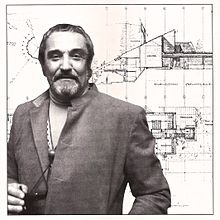Roger D'Astous
hideThis article has multiple issues. Please help or discuss these issues on the talk page. (Learn how and when to remove these template messages)
|
Roger D'Astous | |
|---|---|
 Roger D'Astous (1991) | |
| Born | March 3, 1926 Montreal, Quebec, Canada |
| Died | April 5, 1998 (aged 72) |
| Nationality | Canadian |
| Alma mater | École des Beaux-Arts de Montréal (1946-52), Frank Lloyd Wright, Taliesin East and West (1953) |
| Occupation | Architect |
| Parent(s) | |
| Buildings |
|
Roger D'Astous (March 3, 1926 in Montreal, Quebec – April 5, 1998 in Montreal, Quebec) was a Canadian architect.
Early life[]
Roger D'Astous was the second child of a family of four children. His father (René D'Astous) worked at the local newspaper, and his mother (Corine Basilières) gave him his artistic inspirations.
Studies[]
D'Astous began his schooling with the Sisters of Providence school, before enrolling in science courses at in Montreal in 1940. He began six years later, an architect degree at the École of fine arts in Montreal. After graduating in 1952, he joined the Taliesin Fellowship, where he completed a one-year internship (from August 1952 to July 1953) under the direction of American architect Frank Lloyd Wright in Wisconsin and Arizona, thus becoming the first Quebecer architect to become an apprentice to Wright.

Awards[]
He was recognized with a number of awards during his long career: the Montreal Chamber of Commerce presented him with a Habitas certificate of excellence in 1967 for his achievements in housing design, while in 1987, Roger D'Astous received two awards: the Canadian Wood Council bestowed an award for the Gélinas house and the award of excellence from the Ordre des architectes du Québec. In 1990, the architect was honored with the award of excellence from the Royal Architectural Institute of Canada (RAIC). In a posthumously event, thirteen years after his death, Roger D'Astous was decorated "Grand Artisan" in 2011 from the Minister of Culture and Communications of Quebec, recognizing him as a great contributor to Quebec's cultural scene in the last fifty years.
Archives[]
The Canadian Centre for Architecture archives contains 4,100 drawings, 2,581 photographic materials, 66 publications, 12 notebooks, 7 models, 5 artefacts, and 1.23 meters of textual records from some of his 182 projects which include residential housing, churches and religious buildings, World's fair pavilions, government buildings, commercial buildings, etc.
Book[]
Specialized in the study of contemporary Quebec architecture, Claude Bergeron, a retired professor from Laval University, wrote in 2001, a comprehensive book ("Roger D'Astous Architecte", 234 pages) about the architect's entire professional realizations. The book was published by Les Presses de l'Université de laval.
Documentary[]
Montrealer filmmaker "Etienne Desrosiers" produced in 2016 an extended documentary "Roger D'Astous", 104 minutes, that covers the complete lifespan of the architect. Through his clients and collaborators and by making witty uses of unseen archives, the documentary is a journey through one modernist architecture giant.[1] The film is distributed in Canada by K-Films Amérique (DVD, VOD).
References[]
- ^ By T'Cha Dunlevy, Montreal Gazette, «Roger D'Astous profiles visionary Quebec architect», December 15, 2016 [1]
External links[]
- Canadian architects
- 1926 births
- 1998 deaths
- French Quebecers
- Architects from Montreal
- École des beaux-arts de Montréal alumni